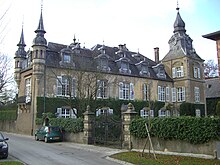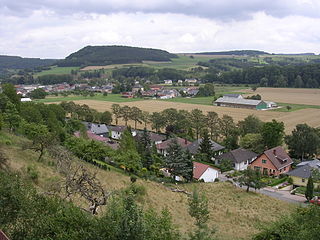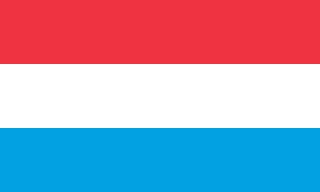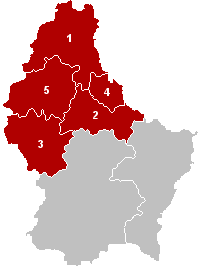
The District of Diekirch was one of three districts of the Grand Duchy of Luxembourg. Immediately prior to its abolition on 3 October 2015, it contained five cantons divided into 43 communes:
- Clervaux
- Diekirch
- Redange
- Vianden
- Wiltz

Úhřetická Lhota is a village in the Pardubice Region of the Czech Republic. It has around 220 inhabitants.
Bleesbruck is a village in the commune of Bettendorf, in eastern Luxembourg. Located nearby is the confluence of the Sauer and the Blees.
Gilsdorf is a small town in the commune of Bettendorf, in north-eastern Luxembourg. As of 2005, the town has a population of 864.
Moestroff is a small town in the commune of Bettendorf, in north-eastern Luxembourg. As of 2005, the town has a population of 405.

Eppeldorf is a village in the commune of Ärenzdallgemeng, in eastern Luxembourg between Bettendorf and Beaufort. As of 2005, the village has a population of 176.

Valley of the Seven Castles is an informal name given to the Eisch valley, in central Luxembourg. The valley stretches from the confluence with the Alzette upstream to Steinfort, on the border with Belgium. The entire route can be traversed in about an hour by car, starting near the town of Arlon on the Belgian/Luxembourg border. There is also a 37-kilometre footpath that takes hikers along the valley and past the castles.
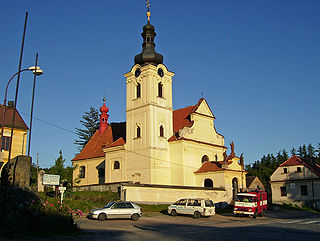
Chocerady is a village in Benešov District, Central Bohemian Region, Czech Republic. It has a population of 1,069.
The Château de Dingy was a castle in the commune of Dingy-Saint-Clair in the Haute-Savoie département of France.

Bourglinster Castle is located in the village of Bourglinster in central Luxembourg some 17 km (11 mi) to the east of Luxembourg City. Now housing a restaurant and facilities for business and cultural gatherings, the castle has a history stretching back to the 11th century.

Larochette Castle stands high above the town of Larochette in central Luxembourg. Dating from the 11th century, the castle was destroyed by fire at the end of the 16th century. Since its acquisition by the State of Luxembourg in 1979, some restoration work has been undertaken.

Hollenfels Castle, with a history dating back to the 11th century, is one of the castles located close to the River Eisch in the Valley of the Seven Castles in central Luxembourg. Today it is used as a centre for activities for young people, including a nearby youth hostel.

Mersch Castle in central Luxembourg is one of the castles belonging to the Valley of the Seven Castles. Located in the centre of Mersch, its history goes back to the 13th century. Today the castle houses the administrative offices of the local commune.

Brandenbourg Castle, now a ruin, is located on a promontory some 70 metres above the village of Brandenbourg in north-eastern Luxembourg. It has a history going back to the 9th and 10th centuries when there was a wooden fort on the site. The 13th century keep, now 11.9 metres high, used to have four floors, only three of which remain. In 1668, the French attacked the castle which subsequently fell increasingly into ruin. It is now owned by the Luxembourg State.
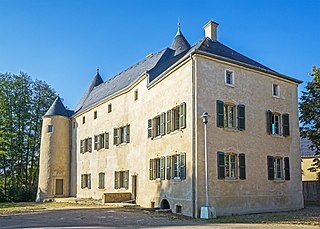
Aspelt Castle, located in Aspelt in the south of Luxembourg, is a Baroque residence built in 1590 on the site of a medieval castle from the 11th century. There are now plans to renovate the building.

Munsbach Castle is located to the southwest of Munsbach near Schuttrange in central Luxembourg. It now belongs to the Institut Universitaire International Luxembourg which provides educational courses in business, European law and public sector management.
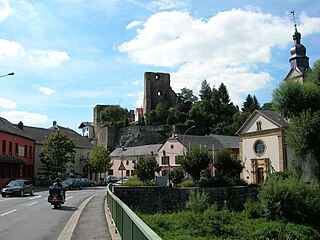
Hesperange Castle is a ruin located high above the town of Hesperange in southern Luxembourg.

Schauwenburg Castle in Bertrange in south-western Luxembourg has a history dating back to the Middle Ages when, according to historical references from the early 13th century, the Lords of Bertrange occupied a fortified castle. Today's building originated in the 16th century as testified by the Renaissance windows on the eastern and northern wings, the façade being completed in 1710. Around 1780, the d'Huart family who lived in the castle found the facilities too small and constructed a larger building, the Château de Colnet d'Huart, in the vicinity. Over the year, the Schauwenburg Castle has had many different owners and has been used for a variety of purposes. Since 2008, it has temporarily housed the Commune's administrative offices and served as the town hall.

Begaly is a town in Aktobe Region, west Kazakhstan. It lies at an altitude of 177 m (581 ft).
